General technical characteristics of the port (I_07)
One of the priority functions of the Port Authority of Huelva is to optimise the layout and condition of its infrastructures so that they adequately meet the needs of its customers.
The general characteristics of the Port of Huelva are as follows:
It is located at the confluence of the rivers Tinto and Odiel and its terrestrial Service Zone has a surface area of 1,784 hectares and an area of land available for concession of 524 hectares. This Service Area is delimited on the right bank by the Juan Carlos I sand containment dyke, 13 km long, and integrated on the left bank by the two port areas in which it is configured: the Inner Harbour and the Outer Harbour.
In the Inner Harbour there are two different port use zones, industrial and commercial:
- The Muelle de Levante area and the Polígono Pesquero Norte, where the main uses are general goods traffic, shallow-draft cruise ships, the fishing industry, commercial and service facilities and machinery maintenance and storage facilities.
- The Punta del Sebo transfer zone, where until very recently, the main uses have been the basic chemical industry and activities complementary to this industry. Faced with the reduction in the number of factories dedicated to basic chemistry, auxiliary industries are gradually being set up. The Marismas del Tinto (marshland) are close to these facilities and constitute an open space where measures have been taken for their recovery and enhancement.
Similarly, in the Outer Harbour, there are also different zones differentiated by the type of activities:
- The area of Muelle Ingeniero Juan Gonzalo and its surroundings, which is mainly used for bulk solid traffic.
- The pontoon area granted in concession, mainly used to handle liquid bulk energy traffic.
- The Muelle Sur, dedicated to container, passenger, Ro-Ro and general cargo traffic.
- In Zone II of port waters to Monobuoy for loading and unloading of crude oil.
In terms of navigable areas, it is worth highlighting the navigation channel, the most relevant characteristics of which are given in the attached table:
| Situation | |
|---|---|
| Longitude (Greenwich) | 6º 49’ 32.8” W |
| Latitude | 37º 8’ 6.6” N |
| Tides | |
|---|---|
| Maximum tidal range | 3.99 |
| B.M.V.V.E. elevation to port zero | 0.07 |
| E.M.V.P. elevation with respect to port zero | 4.05 |
| Prevailing winds | |
|---|---|
| SW and NW | |
| Entrances | |
|---|---|
| Input channel | |
| Width | 200 to 300 m |
| Project draught in B.M.V.E. | 13 m1 |
| Nature of sea bed | Sands and sludges |
| Length | 22,000 m |
| Inlet | |
| Orientation | 339º |
| Width | 300 m |
| Project draught | 13 m1 |
| Maximum current recorded | 5 knots |
| Shelter dams | |
|---|---|
| Juan Carlos I Dam | 13,000 m length |
1) Project draft. The actual draught at any given time shall take into account the minimum sounding corresponding to the last bathymetric survey and shall be consulted through the authorised agents.
The following table summarises the characteristics of the quays and terminals that the Port Authority of Huelva, as a provider of port infrastructures, places at the service of maritime trade.
| Piers, jetties and moorings | Length / Maximum length (m) | Project draught (m) * | Width (m) | Jobs |
|---|---|---|---|---|
| Service | ||||
| Muelle Ingeniero Juan Gonzalo | 942.00 | 13.00 | 230.00 | General cargo and bulk |
| Muelle Ciudad de Palos | 492.00 | 13.00 | 320.00 | General and bulk goods |
| Muelle de Levante Sur | 400.00 | 8.00 | 80.00 | General cargo and passenger |
| Muelle de Levante Central | 90.00 | 8.00 | 80.00 | Local and ancillary fare |
| Muelle de Levante Norte | 710.00 | 8.00 | 80.00 | Fisheries and inland traffic |
| Muelle Petroleros T. Arenillas | 460.00 | 12.60 | --- | Liquid bulk (2 berths) |
| Muelle de Minerales | 374.00 | 13.00 | 50.00 | General cargo and bulk |
| Muelle Sur | 750.00 | 13.00 | 300.00 | Passenger, general cargo, Ro-Ro and containers |
| Muelle de Tharsis | 280.00 | --- | --- | Out of service |
| Mooring buoys North | 200.00 | 7.00 | --- | --- |
| Mooring buoys Centre | 200.00 | 6.00 | --- | --- |
| Mooring buoys South | 150.00 | 5.00 | --- | --- |
| Total service | 5,048.00 | |||
| Private | ||||
| Muelle Nuevo Astillero de Huelva, S.A. | 337.00 (**) | --- | Outfitting, repair, scrapping | |
| Muelle de Riotinto | 390.00 (**) | --- | Out of service | |
| Pantalán de Fertiberia, S.L. (phosphoric) | 180.00 | 8.10 | Liquid bulk | |
| Pantalán Atlantic Copper, S.L.U. Norte | 140.00 | 6.50 (Maximum draught of the vessel irrespective of the tide) | Liquid bulk | |
| Pantalán de Fertiberia, S.L. (Fertilisers) | 150.00 | 8.10 | Liquid and solid bulk | |
| Impala Terminal | 550.00 (**) | 14.00 | Bulk solids | |
| Levantino-Aragonesa de Tránsitos, S.A. | 120.00 | 9.70 | Liquid bulk | |
| Pantalán de Atlantic Copper, S.L.U TNP1 | 175.00 | 10.00 (M: 27.5 m) | Liquid bulk | |
| Pantalán de Atlantic Copper, S.L.U TNP2 | 159.00 | 8.00 (Displacement 20,000 Tm) | Liquid bulk | |
| Muelle de Saltés FPS | 200.00 | 5.50 | Outfitting. repair and scrapping | |
| Pantalán Reina Sofía E de CEPSA | 190.00 | 10.00 | Liquid bulk | |
| Pantalán Reina Sofía C de CEPSA | 128.00 | 8.50 | Liquid bulk | |
| Pantalán Reina Sofía W DE CEPSA | 150.00 | 9.00 | Liquid bulk | |
| Pantalán Reina Sofía 4. º ATRAQUE de CEPSA | 210.00 | 12.00 (Load displacement 66,000 Tm) | Liquid bulk | |
| Pantalán de Enagás, S.A. | 304.50 | 12.00 (LNG carriers up to 180,000 m3) | Liquid bulk | |
| Pantalán de Decal Norte | 210.00 | 11.50 | Liquid bulk | |
| Pantalán Decal Sur | 210.00 | 12.50 (Displacement in load 66,000 Tm) | Liquid bulk | |
| Pantalán Decal Sur2 | 188.00 | 13.30 | Liquid bulk | |
| Real Club Marítimo de Huelva | 16.00 | 2.00 | Various | |
| Marina del Odiel | 40.00 | - | Various | |
| Muelle de La Reina (La Rábida) | 20.00 | 2.00 | Auxiliary (1 berth) | |
| Monobuoy | 275.00 | 16.50 | Liquid bulk | |
| Total private | 4,302.50 | |||
| Total | 9,350.50 |
(*) The actual draught at any given time shall be that of the minimum sounding corresponding to the last bathymetric survey carried out and shall be consulted through the authorised consignees 2644.
(**) Total length of wharf.
The main accesses to the Port of Huelva by road are from the A-49 motorway (Seville-Huelva-Portugal), via the N-441 (to the North), H-31 (to the East) and H-30 (Ronda Este de Huelva), which extends to the South with the N-442, from which the Outer Harbour is accessed. The N-435 (from Badajoz and Zafra to Huelva) is also important for the Port of Huelva in the connection with Extremadura.
Through the connection line with the general network, the Outer Harbour of the Port of Huelva is connected by rail from its rail terminal at Muelle Sur to the Huelva Mercancías rail terminal, a rail logistics centre from which goods are dispatched, received and sorted. From Huelva Mercancías, the Port of Huelva has access to the Huelva-Zafra and Huelva-Sevilla railway lines. Since December 2016, there has been a Port terminal in Majarabique, which forms a node for the distribution of traffic with the rest of the Spanish and European rail network.

Infrastructure under implementation or project and purposes served (I_08)
During 2024, the Port Authority of Huelva has invested 23.9 million euros to adapt its infrastructures to existing needs.
The following relevant measures have been completed this year:
- New Single Access to the Outer Harbour
- Extension of pavement and electrical power at the Muelle de Minerales
- Connection of sewerage from Muelle Sur to the mains network
- Construction works to enable the operation of 550 m long trains at the Majarabique complex
- Rehabilitation of track 2S2
- Extension of the car park at the sebo point
- Refurbishment of Casa del Vigía.
A brief description of these measures is given below:
1. New single access to the Outer Harbour
The works correspond to the creation of an access to the Outer Harbour from the existing oval roundabout type level intersection of the N-442 with the H-624 to Palos de la Frontera and the installation of a new and modern access control. The route is adaptable to the future route of the N-442 proposed by the Ministry of Development.
The work includes a road with a different level crossing to avoid the current railway that runs parallel to the boundary of the Port Authority’s public domain.

2.Expansion of pavement and electrical power at the Muelle de Minerales
The works involved paving the Muelle de Minerales to extend the surface area of use, currently a dirt track; building a new drainage network that flows into the collectors that connect to the recently built retention tank, as well as medium voltage lines to supply the new transformation centre and low voltage installation, in order to comply with the Innovation Plan for Transport and Infrastructures 2017-2025 of the Ministry of Transport, Mobility and the Urban Agenda.
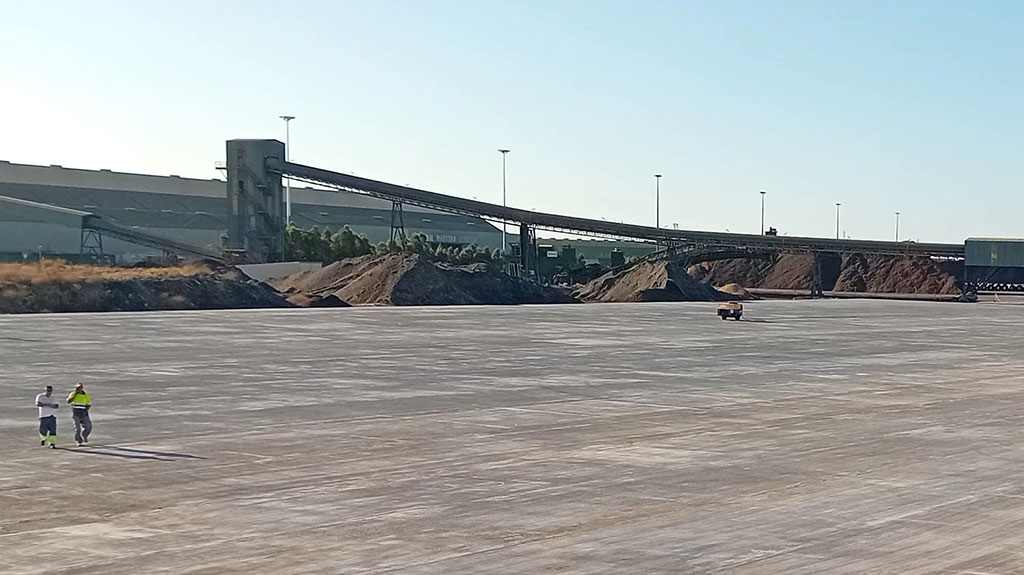
3. Connection of Muelle Sur sewerage to the basic network
The existing sewerage system at Muelle Sur is operated by means of accumulation in tanks. This system was insufficient to meet the needs of all the facilities being developed there, such as the Multifunctional Building and the new reorganisation of accesses to the Muelle Sur, which includes several buildings. There were several settling pits where wastewater is discharged. These are emptied periodically, and are not connected to the basic network.
The new measure involves the development of a sewage collection system that connects Muelle Sur to the Basic Network, specifically at Villafría pumping station, from where it is pumped to the treatment plant.
This action is financed with funds from the Recovery and Resilience Mechanism (RRM).
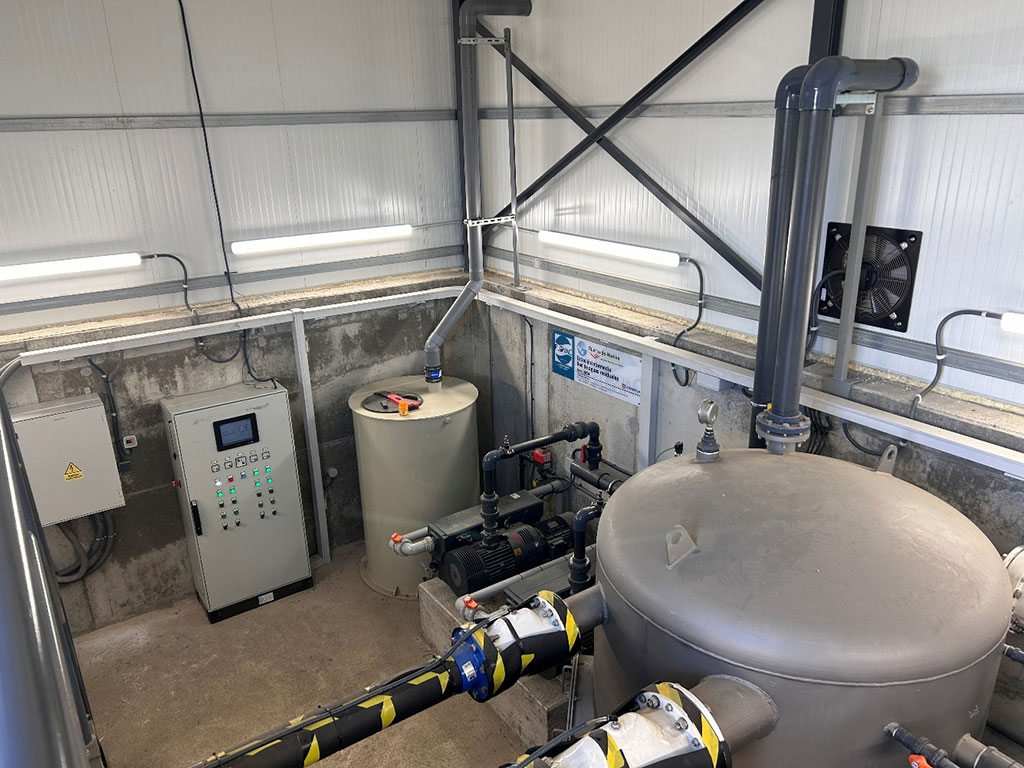
4. Construction project works to enable the operation of 550 m long trains at the Majarabique complex
The Majarabique Intermodal Terminal is a Logistics Platform fully integrated with the Muelle Sur terminal of the Port of Huelva. Its development and specialisation is a priority for the APH due to its location and characteristics.
In response to the need to improve this intermodal platform, the northern railhead of the commercial depots of Majarabique Station has been remodelled in order to obtain a useful track length of 550m on the two tracks granted to the APH. This involves the modification and displacement of the track devices currently installed to permit the rearrangement of the railhead of the set of tracks.
This action is financed with funds from the Recovery and Resilience Mechanism (RRM).

5. Rehabilitation of track 2S2
Since the entry into force of the Railway Sector Act 39/2003, dated 17 November, the Port Authorities of each Port of General Interest have exercised certain functions assigned to the rail infrastructure manager with regard to the existing rail infrastructures in the Ports of General Interest.
For this reason, the Port Authority of Huelva took the decision to improve the railway infrastructure, inherited from the former RENFE in poor condition., Measures have been implemented to improve the entire infrastructure.
The purpose of this project was the renewal of track 2S2 in the following sections:
- Section I: Track 2S2-2 from km. 0+080 to km. 1+178
- Section II: Track 2S2-1 from km. 2+970 to km. 3+740
- Section III: Track 2S2-2 from km. 4+380 to km. 6+340
On these sections, the current supporting layers will be renewed and renovated: sub-ballast and ballast, the current wooden sleepers and the RN-45 type rail will be replaced.
This action is financed with funds from the Recovery and Resilience Mechanism (RRM).
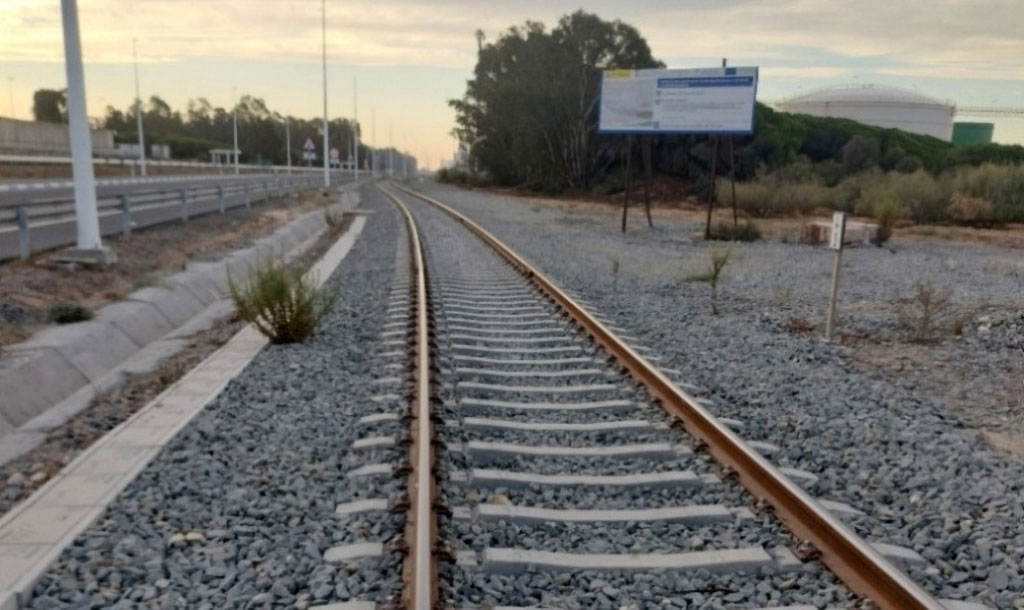
6. Extension of the car park at Punta del Sebo
This measure aims to cover the need to increase the number of parking spaces available in the area surrounding the Columbus monument in Punta del Sebo. The total number of parking spaces obtained is as follows:
- Car parking: 129 spaces
- Parking for people with reduced mobility: 4 spaces
- Parking for motorcyclists: 6 spaces
For the extension of these car parks, the adjoining undeveloped plot of land was used. It was necessary to demolish and dismantle the existing road surfaces and paving, earthworks were required to prepare the land and then road surfaces and paving were laid with drainage, lighting and vertical and horizontal signposting.
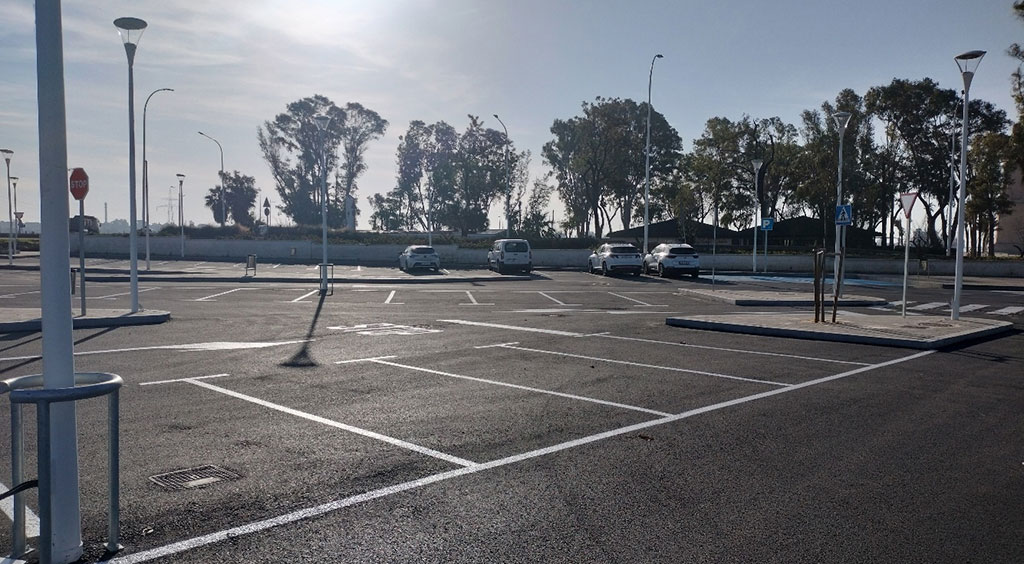
7. Renovation of Casa del Vigía
The Casa del Vigía building was restored by the Port Authority of Huelva in 2006, and ceded to Palos de la Frontera Town Council, together with the Casa de los Prácticos and the Pasarela de Pesca Deportiva, for twenty years, with options to extend. However, before the end of the twenty-year period, these structures reverted to the Port of Huelva.
Once the building had been returned, pathology studies were carried out to determine the state of the building. These studies concluded that these are “structures with deterioration or pathologies that may result in a modification of the resistant behaviour or a significant reduction in service levels” and therefore require renovation.
The purpose of the project was the renovation of the “Casa del Vigía” building owned by the Port Authority of Huelva, located in the municipality of Palos de la Frontera (Huelva).
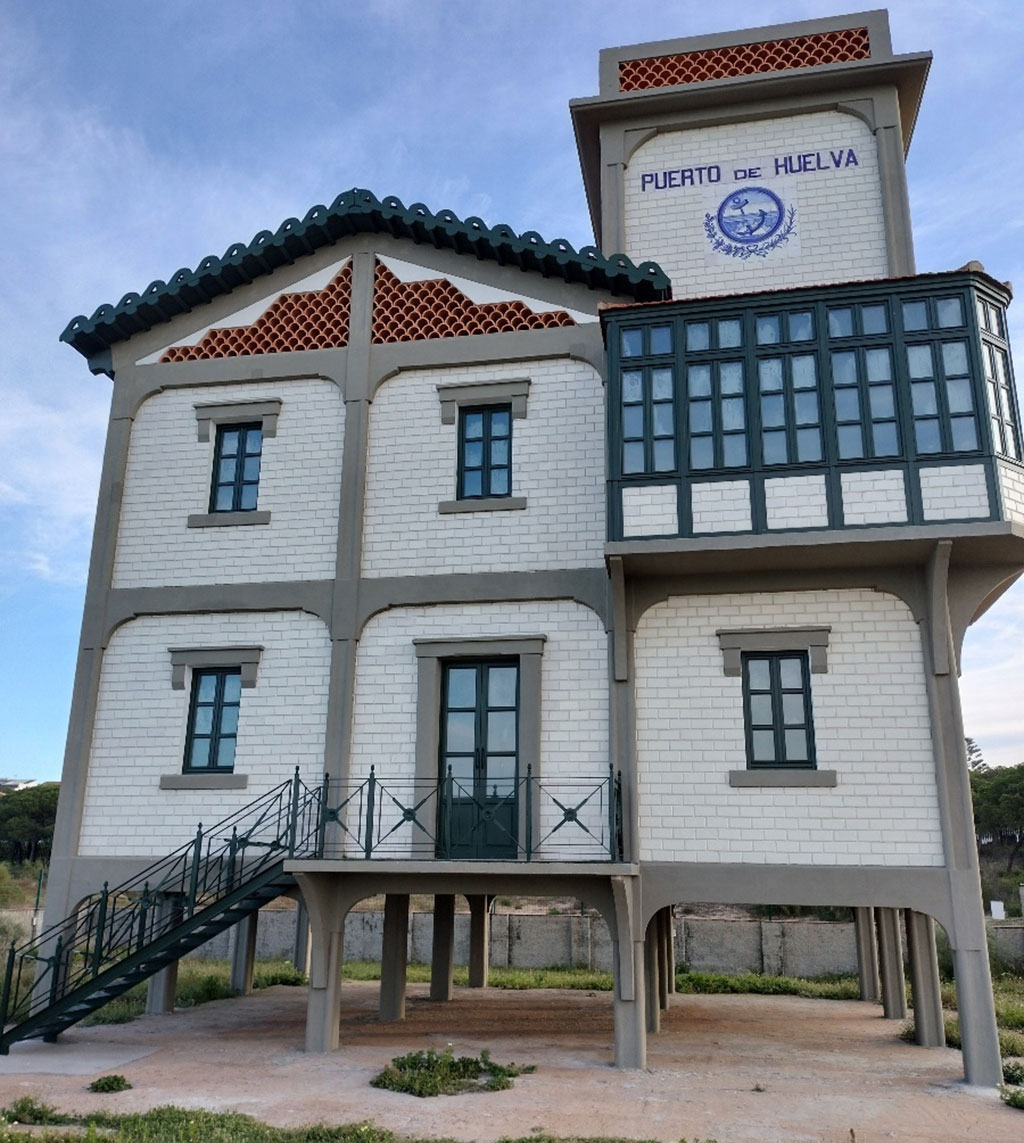
Other measures initiated in previous years and which are still underway include:
- Partial demolition of the fish market and exporter warehouses.
- Renovation to guarantee the stability and structural safety of the loading dock of the Compañía Española de Minas de Tharsis.
- New Ro-Ro Platform at the Port of Huelva Muelle Sur.
A brief description of these measures is given below:
1. Partial demolition of the fish market and exporter warehouses
In recent years, the Port Authority of Huelva has been working hard on the Port-City integration. The integral remodelling of the Muelle de Levante is part of this project. To this end, a number of measures are being carried out, including the partial demolition of the fish market and the exporter warehouses, the construction of the new fish market and new warehouses for fish and seafood exporters.
Both the new fish market and the new exporter warehouses have already been completed, so the object of this measure is the remaining demolition. This involves the partial demolition of the old fish market and the exporter warehouses that still need to be demolished, in order to be able to continue with the integral remodelling of the quay.
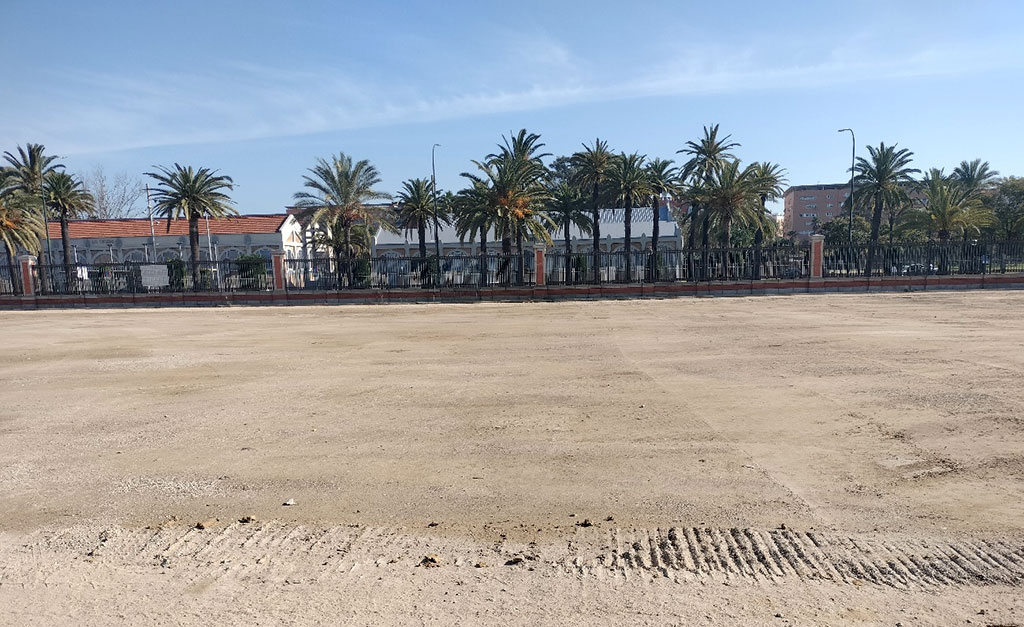
2. Refurbishment to guarantee the stability and structural safety of the Compañía Española de Minas de Tharsis loading dock
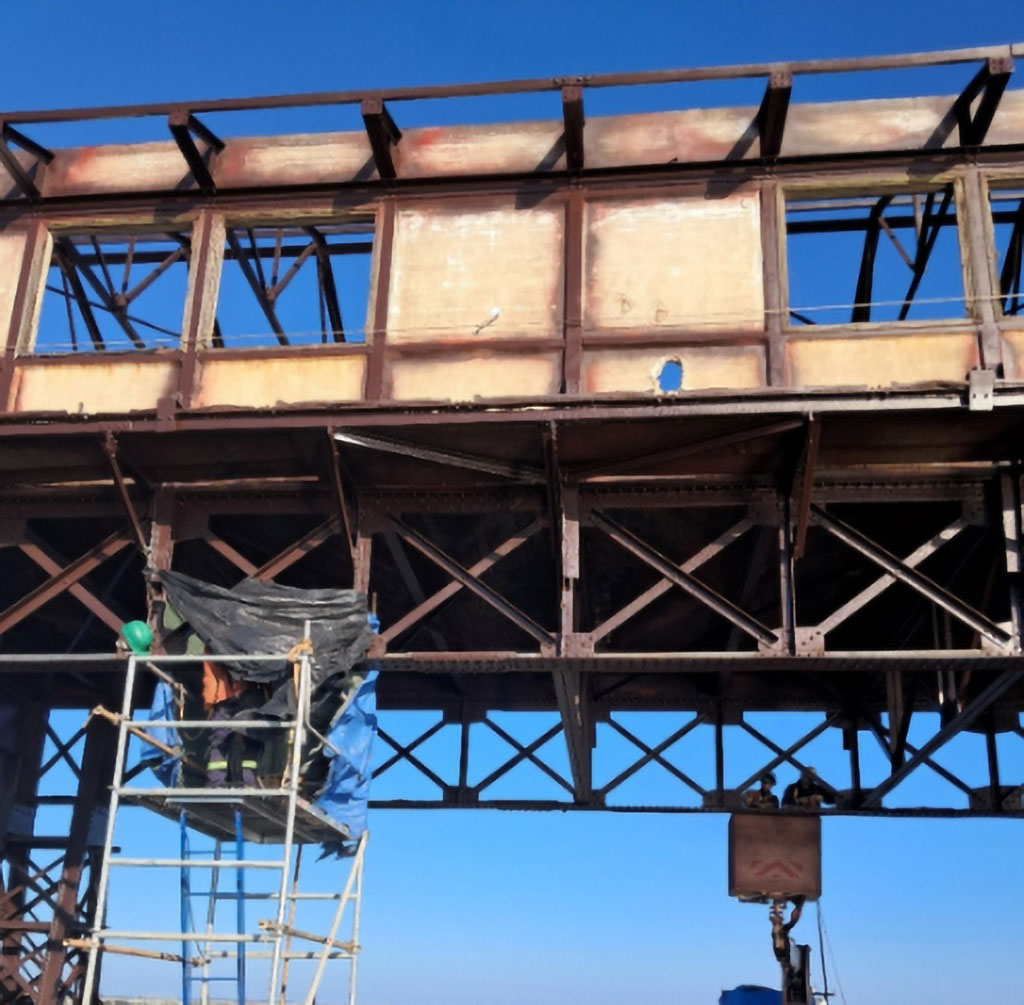
The loading dock of the Compañía Española de Minas de Tharsis is an important symbolic element for the city of Huelva, due to its important role in the economic and social evolution of the surrounding area and its link to its recent history. It is a sign of identity that the general public are calling for to be restored.
The works entail a series of measures necessary to guarantee the stability and structural safety of the loading dock, as the general state of deterioration of the structure of the dock is currently very advanced.
3. New Ro-Ro Platform at the Port of Huelva Muelle Sur
Most of the loading and unloading operations at Muelle Sur are carried out by roll-on roll-off operations through ramps located at the stern of the vessels. At present, the quay has a ramp for Ro-Ro vessels 200 m from the southern end, with capacity for 2 vessels, allowing the operation of vessels of about 175 m in length and 27 m in beam.
Due to the recent increase in this type of traffic, following the implementation of a new regular line to the Canary Islands, and given the forecasts for growth and the implementation of new regular ro-ro lines with North Africa, it is necessary to improve the quay’s operations by building a new Ro-Ro ramp at the southernmost end of the quay, compatible with the current ramp, so that in the future up to four Ro-Ro vessels can operate simultaneously.

In addition, the following proceedings were initiated:
- Cold pipeline network.
- Fishing dock on the Muelle de Levante Norte.
- Demolition of former ice factory.
1. Cold pipeline network
The so-called Cold Logistics Hub of the Port of Huelva, located in the Multimodal Platform “Muelle Sur”, aims to turn the Huelva enclave into a centre of reference and excellence in the logistics of temperature-controlled goods. This is both from the point of view of operational efficiency and from the point of view of both economic and environmental sustainability, and will be a differentiating aspect with respect to any other facility known to date in Europe.
This economic and environmental sustainability, the differentiating factor of the Cold Logistics Hub of the Port of Huelva, is motivated by the possibility of an ecological and low-cost refrigeration energy supply from the Liquefied Natural Gas regasification process.
In light of the above, the aim is to execute the cold pipeline network project from the Enagás regasification terminal to the destination point in the so-called Cold Logistics Hub located at Muelle Sur.
This action is financed with funds from the Recovery and Resilience Mechanism (RRM).
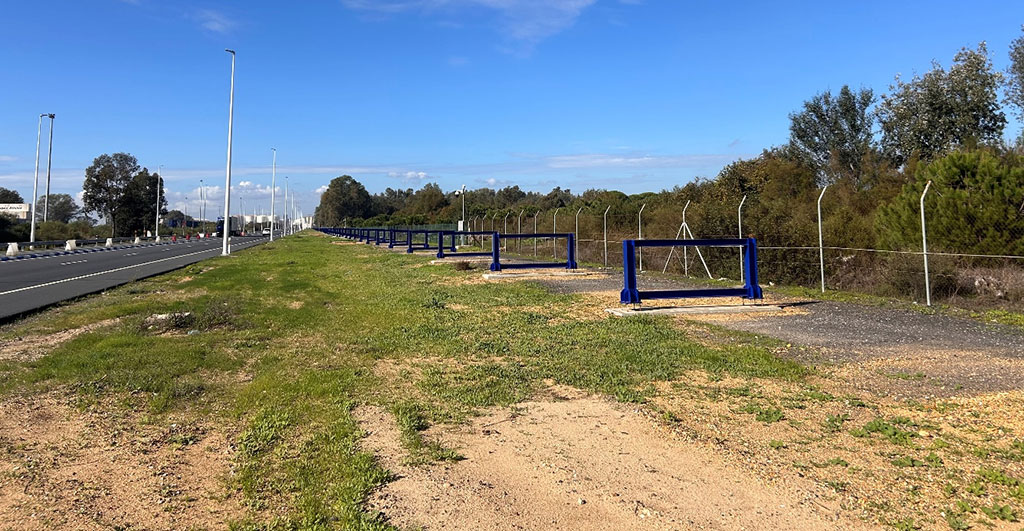
2. Fishing dock at the Muelle de Levante Norte
A new pontoon has been designed to meet the surplus demand for berthing fishing vessels at the Muelle de Levante Norte of the Port of Huelva, which involves the extension of 96 metres of berthing line in front of the Port’s fish market. Only the front face of the pontoon (further into the estuary) is designed as a mooring line, in such a way as to ensure adequate draft for the larger vessels that will operate there and space for their manoeuvrability.
The solution adopted involves the construction of a floating pontoon of piled concrete that starts one metre from the last step of the existing stairs leading up to the quay such that the use of these stairs is respected. The infrastructure consists of eight 12×3 m floating concrete modules and an intermediate 6×3 m aluminium floating pontoon that will support the gangway and will be the means of transition to access the floating pontoon.
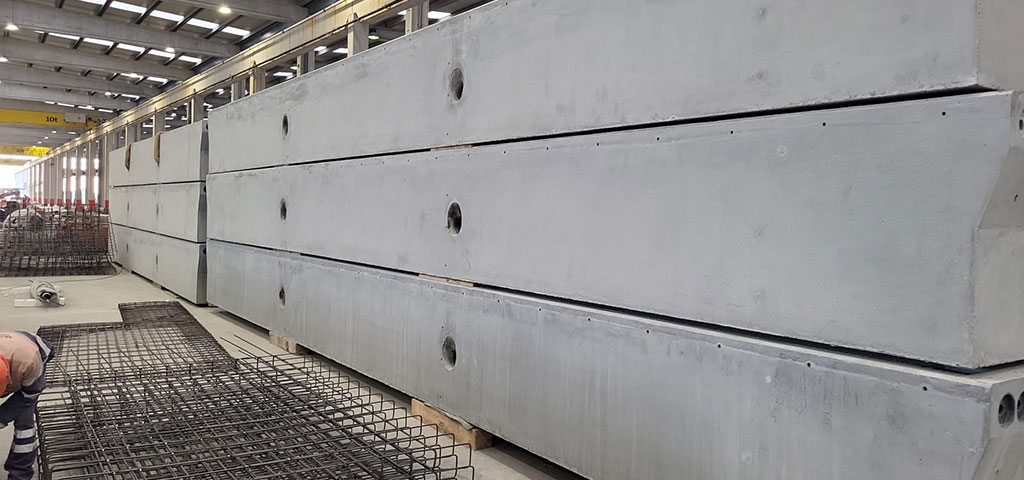
3. Demolition of former ice factory
As part of the Port-City project, the Port Authority of Huelva is carrying out the integral remodelling of the Muelle de Levante. The first phase involves the dismantling of the obsolete buildings, including the old building which once housed the installations of the Expofrisa company (cold stores, offices, ice factory, etc.), currently out of use and abandoned.
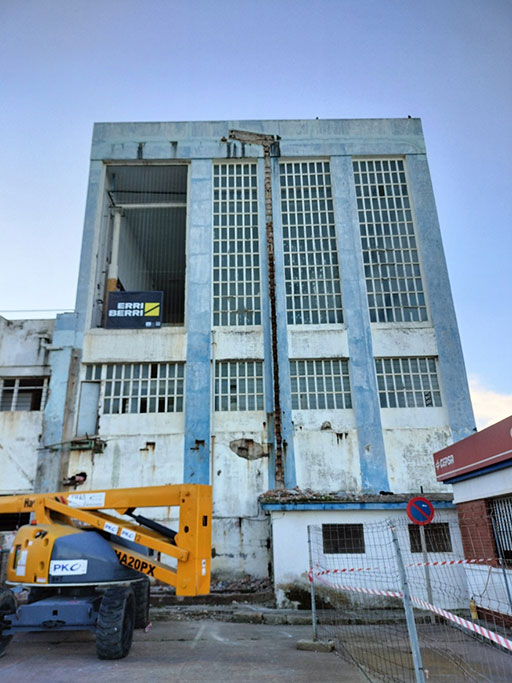
Therefore, the object of the measure is the complete demolition of the building corresponding to the former installations of the company Expofrisa.
In addition to the projects necessary to implement some of the investments described above, a number of projects have been drafted during 2024, some of which are still underway, including the following:
- Dredging product enclosure project no 4 phase 2
- Rail Terminal Expansion Project
- Muelle de Levante Remodelling Project
- Dock project for liquid bulk terminal south of the Muelle de Ingeniero Juan Gonzalo
- Parking and underground routing of Avenida Hispanoamerica
- Muelle Sur Paving Project
- EstiHuelva Enabling Project
- Project for Muelle de Riotinto Union
Industrial promotion and logistics initiatives (I_09)
The mission and vision expressed in the Port’s Strategic Plan explicitly identify the improvement of the Port’s connectivity and intermodality as a determining factor that has led the Port to focus on its development, especially with regard to rail transport.

The strategic relevance of intermodality in the Port of Huelva is currently based on four key pillars:
a) The Majarabique Intermodal Railway Platform, located in Seville and owned by the Port Authority of Huelva.
b) The Logistics Activity Zone, currently being planned, which will allow the confluence of different types of companies and activities that provide continuity, quality services, transformation and added value to the transport chains that converge in the port area.
c) The Port’s rail infrastructure and connectivity, which will allow more sustainable and efficient access to maritime transport. (See I_22).
d) The Multimodal Platform of the Port of Huelva, co-financed by the CEF Programme (Connecting Europe Facility) and located at Muelle Sur of the Port with direct connection to the maritime container terminal. (See I_22).
For the Huelva Port Authority, the Majarabique Railway Terminal is a project integrated with its maritime terminal and is considered a true “extension” of the terminal.
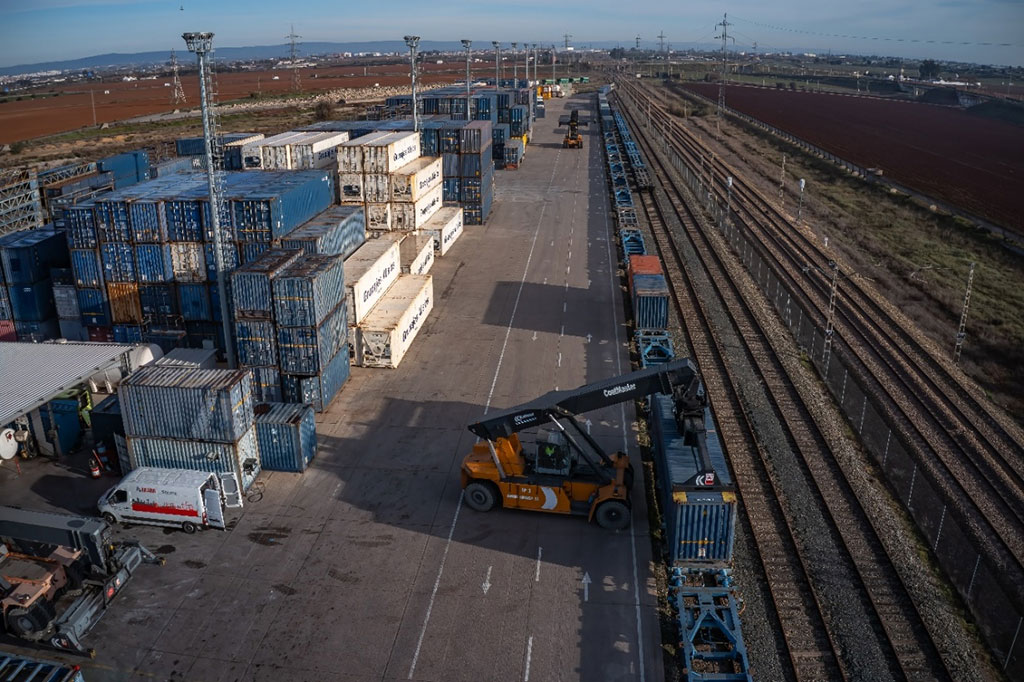
It is located in the northern area of Seville, in the municipalities of Seville and La Rinconada, adjacent to the SE-20 and SE-40 ring roads and the northern access to Seville, and forms part of the Seville railway junction with Madrid and Extremadura, thus enabling a direct and efficient railway connection between the hinterland of the Port of Huelva located in the Mediterranean and Atlantic corridors and with Extremadura.
It is a priority for the Port of Huelva to continue consolidating, strengthening and specialising this terminal, as its position makes the Port of Huelva an even more attractive option for maritime routing of containerised rail cargo from the central axis (Cordoba, Jaen, Castilla La Mancha, Madrid and Zaragoza), with Atlantic ports as destinations (Canary Islands, West Africa, Latin America and North-West Europe, among others), achieving optimised times and costs in the entire logistics chain.
Particularly noteworthy is the investment effort that the Port Authority is making in Majarabique and the Seville-Huelva railway section, with the creation of new sidings to speed up the transport of goods to their destination, with a value of €11 million.
On 23 January 2017, ADIF and the Port Authority of Huelva signed a contract for the lease of a plot of land for the development of a loading and unloading point for goods transported by rail at the Seville Majarabique facility, with several extensions having been carried out to date. It now has a total surface area of 67,550 m2.
The operation of this Railway Terminal was awarded by public tender to the company Termisur Eurocargo, S.A., which started its activity there in July 2017. From then until today, the rate of container rail traffic from Majarabique to the Port of Huelva is close to forty trains per month, distributed in an average of twenty direct trains between Majarabique and Muelle Sur of the Port of Huelva, and the twenty trains per month coming directly from the hinterland of Madrid.
The strategic importance of Majarabique encouraged the Port of Huelva to join the Andalusian Logistics Network in November 2020, with the aim of developing this Logistics Area of the Andalusian Regional Government, which was approved and declared of general interest by the Governing Council on 6 November 2018.
In 2024, work was completed on the extension of the track, which will allow access to trains of more than 550 m in length, and on the storage and operating area adjacent to the track.
Rail connections
Three per week:
- Majarabique – Puerto Huelva.
RENFE Multiclientes. Three per week. Majarabique connection with:
- Madrid Abroñigal
- Barcelona Morrot
- Tarragona Constanti
- Bilbao Mercancías
- Bilbao Noatum
Three per week:
- Madrid – Puerto Huelva
The Logistics Activity Zone (ZAL) project, essential for the future development of the Port of Huelva and its entire area of influence, has a surface area of approximately 60 hectares, with the possibility of expansion, and is located in Punta del Sebo. This area has is of marked industrial character and offers availability of land with services and good road and rail accessibility.
The ZAL will occupy a central position between the Port of Huelva and the urban centre. This will allow the confluence of different types of companies and activities that provide continuity, quality services, transformation and added value to the transport chains that converge in the port area, as well as favouring the generation of employment, the loyalty of current traffic and the promotion of new future traffic.
This project is essential for generating added value in Huelva and promoting the development of the business fabric and the generation of stable employment, with a clean processing industry.
The ZAL will occupy a central position between the Port of Huelva and the urban centre. This will allow the confluence of different types of companies and activities.
The ZAL of the Port of Huelva will optimally serve the sectors of greatest relevance and activity in the surrounding area, having identified key sectors for business projects in specialised logistics activities:
- Generalist logistics.
- Agri-food sector.
- Industrial-Logistics Sector.
- Health Sector.
During 2024, the tender for the construction and operation of the first phase of the ZAL was awarded to the joint bid submitted by the companies, Inversiones Onuba and Alvores Developments.
Furthermore, in the field of industrial promotion, in 2024 work continued in various working groups with institutions such as AIQBE (Association of Chemical, Basic and Energy Industries of Huelva), IDEA Agency and “Invest in Andalusia”, with the aim of integrating the industrial and logistics projects of the Port Community companies in the Port’s plans, as well as promoting the available land in the Service Area to attract new investments.